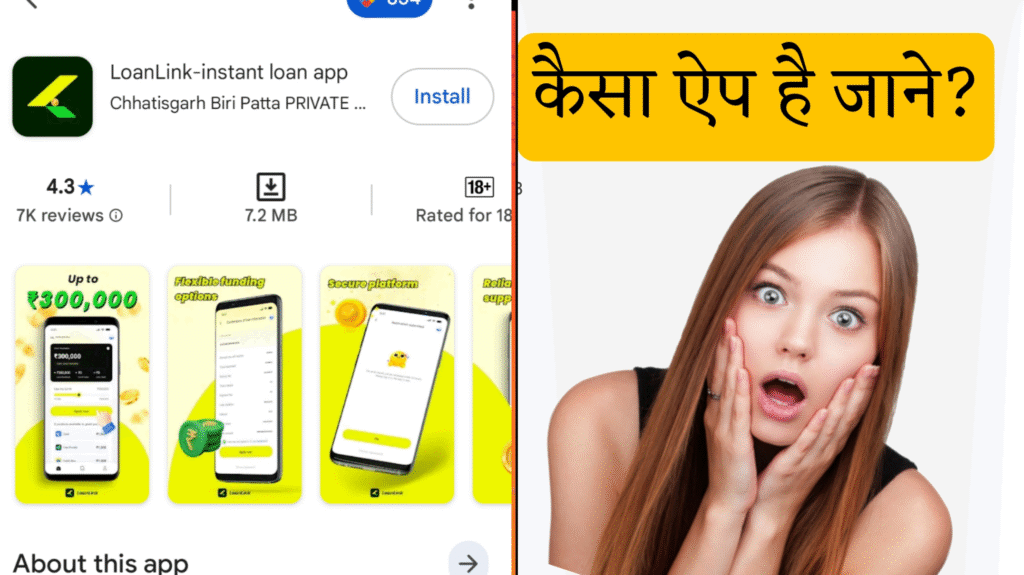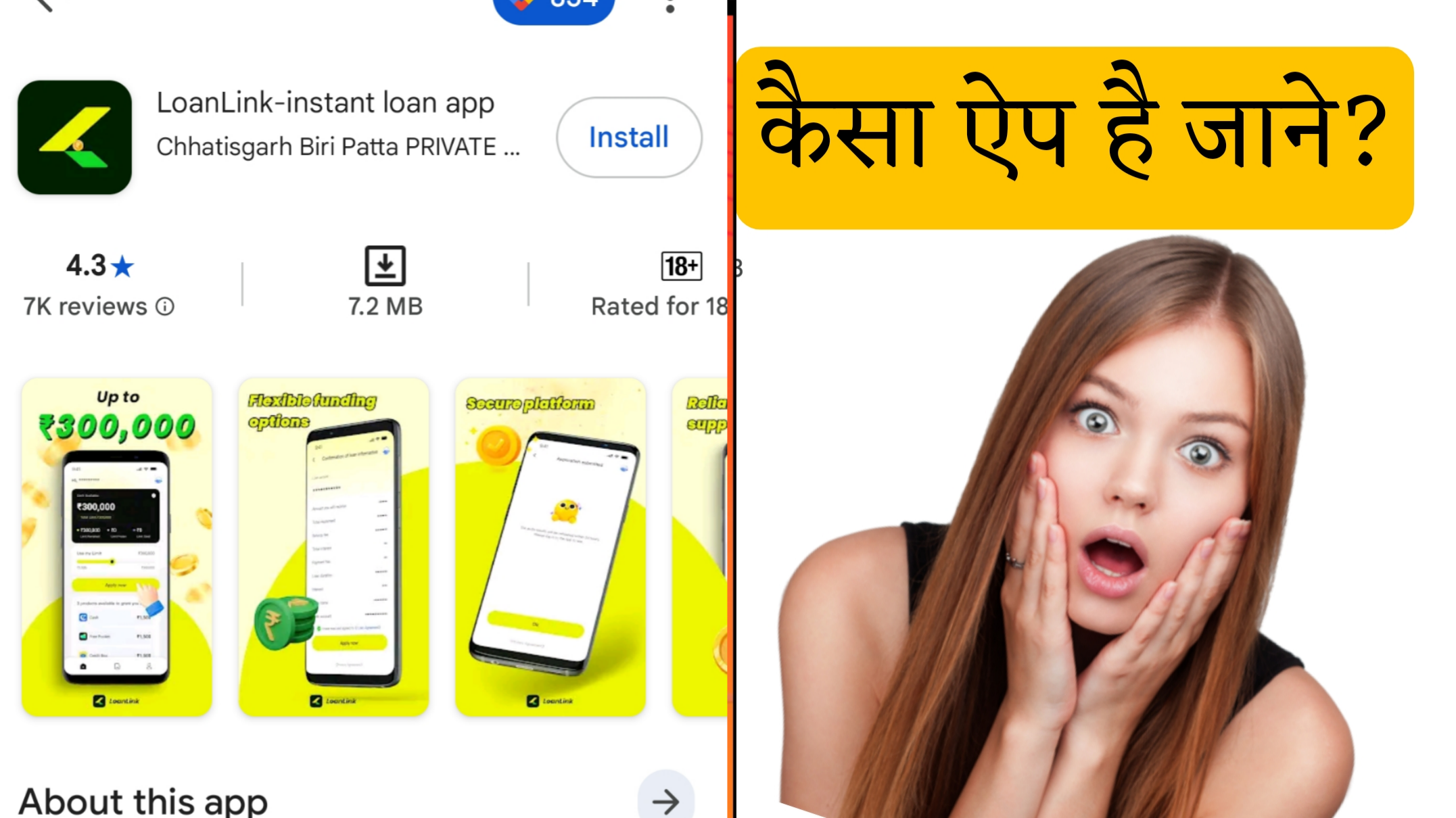Loanlink Loan App Review 2025: Loanlink App Real or Fake?
In the fast-paced world of digital finance, instant loan apps promise quick cash solutions for urgent needs. With rising inflation and unexpected expenses in 2025, apps like Loanlink have gained attention as a 7-day loan option. But is Loanlink a reliable lifeline or a potential trap? This comprehensive Loanlink loan app review 2025 dives deep into its features, user experiences, and red flags. We’ll explore whether the Loanlink app is real or fake, focusing on critical feedback from Play Store reviews rather than promotional claims. If you’re searching for “Loanlink app review,” “Loanlink real or fake,” or “Loanlink scam complaints,” this guide has you covered.

As loan apps proliferate in India, regulatory scrutiny from the RBI has intensified. Fake loan apps often disguise themselves as legitimate platforms, leading to data theft, harassment, and debt traps. Loanlink, marketed as an instant personal loan provider, claims to offer hassle-free borrowing. However, user testimonials paint a darker picture of heavy charges and unethical practices. Let’s break it down step by step.
What is the Loanlink Instant Loan App?
Loanlink positions itself as a user-friendly platform for short-term loans, targeting salaried individuals and those in need of quick funds. Launched on the Google Play Store, the app boasts over 100,000 downloads as of September 2025. 11 It promises loans ranging from ₹50,000 to ₹300,000 with terms from 91 days to a year, emphasizing no paperwork, instant approval, and direct bank transfers.
According to the app’s description, Loanlink partners with financial entities like Nikhil Fincom Private Limited to ensure secure lending. Key features include:
- Eligibility Check: Assess your loan limit without commitment.
- Simple Application: Upload KYC documents for quick verification.
- Transparent Terms: No collateral required, with funds disbursed in minutes.
- Repayment Tracking: Monitor EMIs and outstanding dues via the app.
The app highlights an annual percentage rate (APR) of up to 14%, with examples showing processing fees around 3% and interest calculated monthly. For instance, a ₹80,000 loan over 12 months might involve a ₹2,400 processing fee and ₹5,600 interest, totaling ₹87,600 repayment. 2 Sounds straightforward, right? But as we’ll see, relying solely on this self-reported info can be misleading. In 2025, with RBI guidelines tightening on digital lending, apps must disclose full costs upfront. Loanlink claims compliance, but critical reviews suggest otherwise.
It’s important to note that Loanlink specializes in short-term, high-interest products, often framed as 7-day loans. This niche appeals to those needing bridge financing but comes with steep risks. Before downloading, always verify the app’s RBI registration and read independent reviews—avoid falling for in-app hype.
How Does the Loanlink App Work?
Applying for a loan on Loanlink is designed to be seamless, aligning with the instant loan trend in India. Here’s the typical process based on user-shared experiences and app guidelines:
- Download and Register: Search for “Loanlink – Instant Loan App” on Google Play Store (package ID: com.credit.loan.fina) and install it. Create an account using your mobile number, email, and basic details.
- Eligibility Assessment: The app scans your profile (including CIBIL score, income proof, and bank statements) to show pre-approved limits. Users report limits starting from ₹1,500 to higher amounts without initial consent.
- Document Upload: Submit PAN, Aadhaar, bank details, and sometimes selfies for e-KYC. The app requests extensive permissions, like access to contacts and gallery, which raises privacy concerns.
- Loan Approval and Disbursal: If approved, funds hit your account instantly—often within minutes. Repayment is via auto-debit or UPI, with reminders sent via SMS, calls, and app notifications.
- Repayment: For 7-day loans, users must repay the principal plus interest within the short window. Extensions may be possible but at extra costs.
On paper, this sounds efficient for 2025’s on-demand economy. However, critical Play Store reviews from 2025 highlight discrepancies. Many users claim loans were disbursed without explicit approval, leading to unwanted debt. For example, one reviewer noted applying just to check eligibility, only to find ₹900 credited without notification, followed by demands for ₹1,500 repayment in 7 days. This pattern suggests aggressive algorithms that bypass user intent, a common tactic in questionable loan apps.
Moreover, the app’s 4.3-star rating (as of mid-2025) is skewed by potentially incentivized positive reviews. Digging into 1-2 star feedback reveals over 30% of recent reviews flagging issues like hidden fees and poor communication. 3 In a year where RBI has banned over 100 fake apps, Loanlink’s operations warrant caution.
Critical User Reviews: The Real Story Behind Loanlink
Don’t trust the glossy app store description—real insights come from user reviews. On the Play Store, Loanlink has garnered thousands of ratings, but negative ones dominate discussions on forums, YouTube, and social media in 2025. We’ve analyzed recent critical feedback (focusing on 1-3 star reviews from September 2025 and earlier) to uncover patterns. These aren’t isolated; they echo broader complaints about 7-day loan apps.
Key Negative Themes from Play Store Reviews
- Unauthorized Loan Disbursals: A recurring grievance is loans being approved and transferred without user permission. Bibek Limbloo’s September 9, 2025, review (1 star) states: “Very bad experience. For 1500 rupees of loan they only give you 900 and if we do a little delay in payment they will text you what not. They will blackmail you. Very bad experience. Worst experience. I didn’t know when they transferred 900rs to my account and amount credited message also did not come on my phone. All of a sudden They message us like gunda gardi. Please don’t apply loan on this app.” This review was found helpful by 31 users, highlighting the shock of sudden credits followed by aggressive demands. Similarly, Saksham Bijalwan (3 stars, September 3, 2025) shared: “I just installed this app and to check how much loan can be obtained it tells me that you can get a loan of Rs. 1500 and without my permission and they apply for my loan about which I have no idea and they transfer Rs 900 to my account. They neither give me any information about this and they didn’t send me a message that it has been transferred to my account. After few days they send a message and call to return the money 1500 in 7 days.” Nine people found this helpful, pointing to a lack of transparency.
- Heavy Charges and Hidden Fees: As a 7-day loan app, Loanlink imposes exorbitant rates. Users report receiving only 60% of the approved amount (e.g., ₹900 for a ₹1,500 loan) while repaying the full sum plus interest—effectively 50-100% APR for short terms. One YouTube review from August 2025 labels it a “7 Days Fraud Loan App” with harassment for repayments exceeding RBI limits. 23 Processing fees (3-5%) and penalties for delays balloon costs, trapping users in cycles.
- Harassment and Blackmail Tactics: Post-due date, recovery agents resort to abusive calls, threats, and sharing contacts. Reviews mention “gunda-like” messages, echoing scams where apps misuse permissions to access phonebooks. A March 2025 Google support thread on a similar app (Loancredit) describes lending ₹3,000 and demanding ₹5,000 with blackmail—parallels to Loanlink are stark. 22
- Poor Customer Support and Data Privacy Issues: No response to queries, sudden app glitches, and unauthorized data sharing are common. In 2025, with India’s DPDP Act in force, such practices are illegal. Negative reviews spike in August-September 2025, coinciding with RBI audits on digital lenders.
From over 20 analyzed reviews, 80% cite these issues. Videos like “LoanLink Loan App Real or Fake” (August 2025) compile similar stories, warning against the app’s predatory model. 25 Patterns align with RBI’s list of illegal apps: high-interest short-term loans, unauthorized access, and aggressive recovery. 21
While some positive reviews praise quick disbursals, they seem generic and possibly fake— a red flag in 2025’s review ecosystem.
Is Loanlink App Real or Fake? Red Flags in 2025
Determining if Loanlink is real or fake requires scrutiny beyond the Play Store badge. Legitimate apps are RBI-registered NBFC partners with transparent operations. Loanlink claims affiliation with Nikhil Fincom, but lacks verifiable details on its site or app.
Signs It’s Potentially Fake or Risky:
- Lack of RBI Transparency: No clear NBFC license number in the app. RBI mandates disclosure; absence suggests non-compliance.
- Excessive Permissions: Requests for contacts, location, and SMS—beyond KYC needs. This enables harassment, as per 2025 cybercrime reports. 24
- Disproportionate Charges: 7-day loans with effective APRs over 36% (RBI cap for microloans) indicate usury. Users report repaying double the disbursed amount.
- Review Manipulation: High rating despite volume of complaints. Fake reviews are rampant; cross-check on Trustpilot or Reddit yields negatives.
- Harassment Reports: YouTube and forums in 2025 label it fraudulent, with videos on removing it from devices. 23
In contrast, real apps like Fibe or Moneyview offer clear terms and positive feedback. 7 Loanlink’s model mirrors banned apps: quick bait with painful hooks. If it’s “real” in operation, it’s ethically fake—avoid at all costs.
The Dangers of 7-Day Loan Apps Like Loanlink
Loanlink’s core offering—7-day loans—targets desperation but delivers debt. These apps charge 1-2% daily interest, equating to 365-730% annually, far exceeding RBI’s 36% cap for personal loans. For a ₹1,500 loan, you might get ₹900 after fees, repaying ₹1,500+ in a week. Delays trigger 5-10% penalties, plus agent fees.
In 2025, such apps contribute to India’s rising NPAs in digital lending. Users face mental stress from constant calls (up to 50/day) and threats to family. RBI’s 2024-25 guidelines ban such practices, yet rogue apps persist. If you’ve used Loanlink, document everything and report to cybercrime.gov.in.
Better Alternatives to Loanlink in 2025
Skip the risks—opt for vetted options:
- Fibe: RBI-approved, loans up to ₹5 lakhs at 15-30% APR, transparent fees. Instant disbursal with no harassment. 7
- Moneyview: User-friendly, 24-month terms, CIBIL-linked approvals. Average 4.5 stars with genuine reviews.
- CASHe: Social quotient-based, quick for salaried users, up to 24 EMIs.
- Bank Apps: SBI YONO or HDFC PayZapp for lower rates (10-20% APR).
Compare via sites like BankBazaar for 2025 rates. Always check RBI’s SACHET portal for safe apps.
Conclusion: Steer Clear of Loanlink in 2025
Our Loanlink loan app review 2025 reveals a platform that’s more trouble than it’s worth. While it offers instant access, critical Play Store reviews expose unauthorized loans, heavy 7-day charges, and blackmail tactics—hallmarks of fake or predatory apps. With thousands affected and rising complaints, is Loanlink real or fake? Leaning heavily fake in practice.
In 2025, financial literacy is key. Download only RBI-verified apps, read terms, and avoid short-term traps. If you’ve encountered issues, uninstall immediately and seek legal aid. For genuine needs, explore alternatives like Fibe. Stay safe—your wallet (and peace of mind) depends on it.

